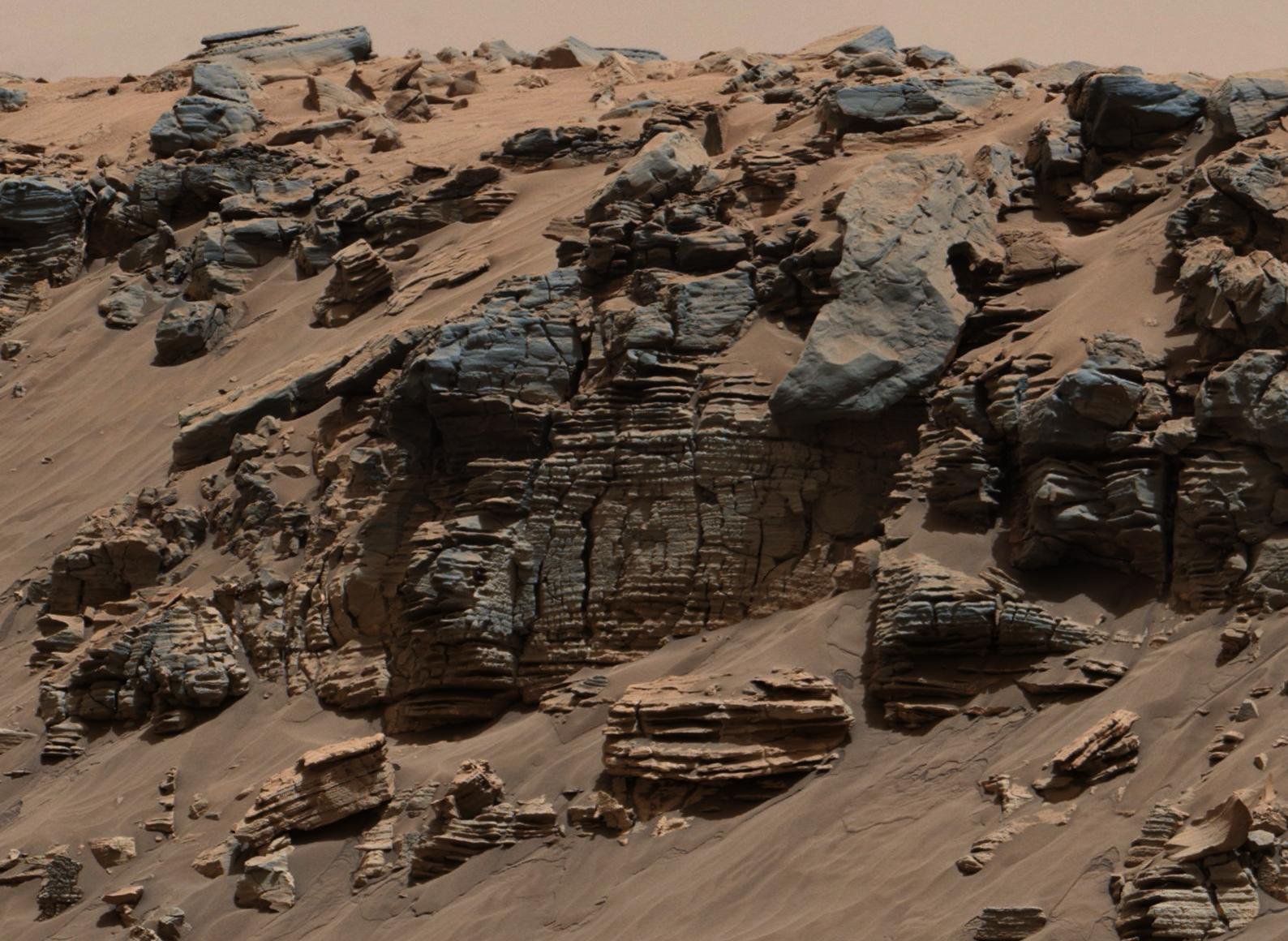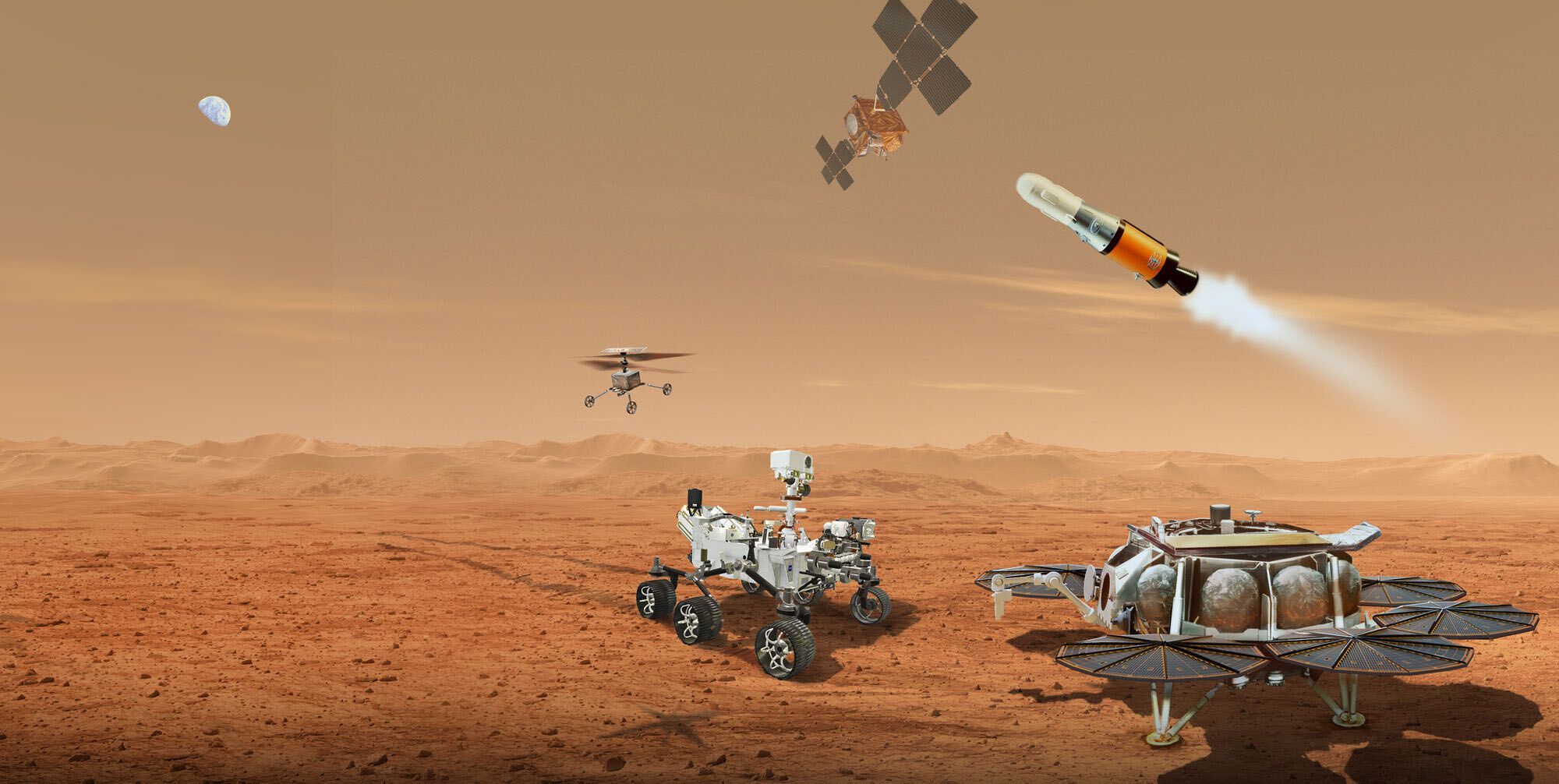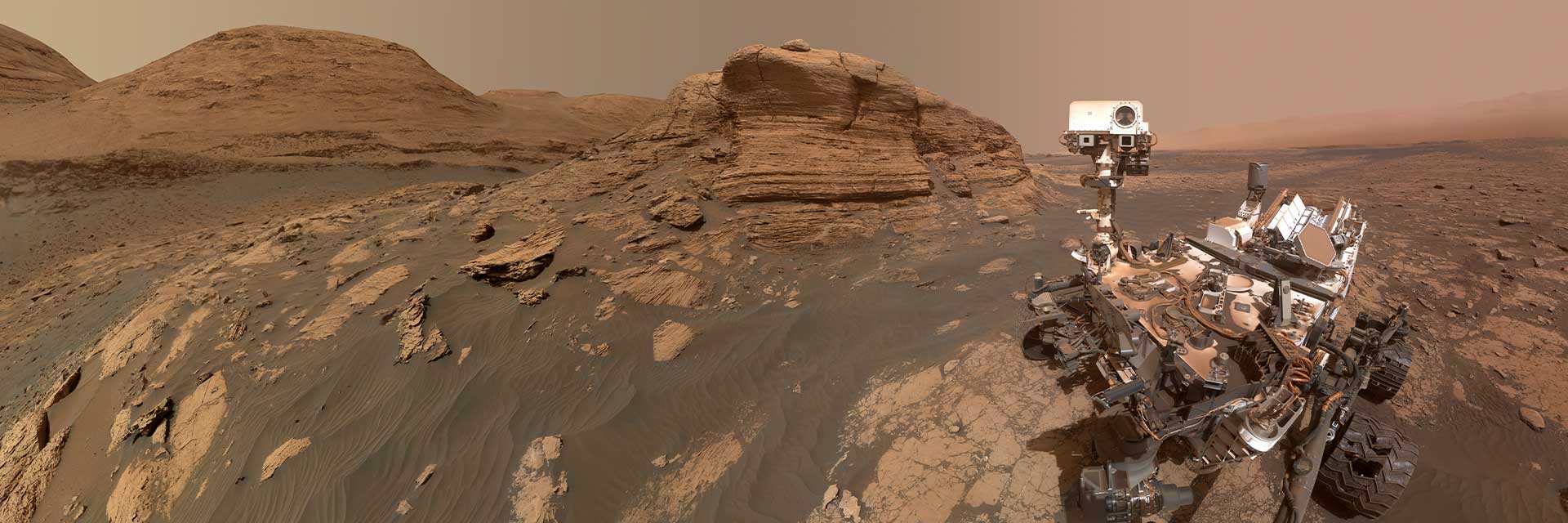
Mars Exploration Science Goals
The key to understanding the past, present or future potential for life on Mars can be found in NASA’s four broad, overarching goals for Mars Exploration.
Determine Whether Life Ever Arose on Mars
Conditions Needed for Life to Thrive
On Earth, all forms of life need water to survive. If life ever evolved on Mars, it likely did so in the presence of a long-standing water supply. That's why our search for evidence of life on Mars focuses on areas where liquid water was once stable, below the surface where it still might exist, or in current "hot spots" where hydrothermal pools (like those at Yellowstone) might be habitable. Data from multiple NASA Mars missions suggest the presence of liquid water just below the surface in rare places, and on water ice at the Martian poles. Mars missions also search for energy sources other than sunlight, since life on the Mars surface is unlikely because "superoxides" break down organic (carbon-based) molecules on which life is based. We find life on Earth in many places without sunlight--dark ocean depths, inside rocks, and deep below the surface. Chemical and geothermal energy, for example, are also energy sources for life forms on Earth. Perhaps tiny, subsurface microbes on Mars could use such energy sources, too.
Looking for Life Signs
Differentiating life from non-life is a challenge, no matter where one finds it. On Earth, we know which markers, or biosignatures, to look for, but life on another planet might be very different in chemistry, structure, and other characteristics. Life detection technologies under development will help us define life in non-Earth-centric terms, to detect it in all the forms it might take. In the meantime, NASA Mars missions look for telltale biosignatures of current and past life. Knowing the location and form on Mars of the element carbon, a fundamental building block of life, would tell us a lot about where life might have developed. The current Martian atmosphere consists mostly of carbon dioxide. Any discovery of carbonate minerals formed on the Martian surface by chemical reactions between water and the atmosphere would be a clue that water had been present for a long time--perhaps long enough for life to have developed. By studying fossils in sedimentary rock on Earth that leave a record of past life, we know that only certain environments and types of deposits preserve fossils well. We look for lakes and streams on Mars that may have left behind similar deposits.

Characterize the Climate of Mars
What's the Martian Climate Like Today?
The current Martian climate is regulated by seasonal changes of carbon dioxide ice caps, atmospheric movement of large amounts of dust, and water vapor exchange between the surface and atmosphere. One of Mars' most dynamic weather patterns is the generation of dust storms, generally in the southern spring and summer. These storms can grow to encompass the whole planet. Understanding how these storms develop and grow is one science goal.

What Can the Current Climate on Mars Reveal about the Past?
A better understanding of Mars' current climate helps scientists more effectively model its past behavior. To do this, they need Mars weather maps and information about quantities of dust and water vapor in the atmosphere. Monitoring the planet for this information over one full Martian year (687 Earth days) and repeated years helps us understand how Mars behaves over its seasonal cycle and guides us toward understanding how the planet changes over millions of years. The layered terrain of Martian polar regions also holds clues about the planet's past, much as a tree's rings provide a record of its history. When and how were these polar layers deposited? Was the climate of Mars ever like that of Earth? And if so, what happened to change the planet into the dry, cold, barren desert it is today? Our current missions are striving to answer those important questions.
Characterize the Geology of Mars
How did Mars become the planet we see today? What accounts for the differences and similarities between Earth and Mars? Studying Mars' geology helps answer these questions. We work to understand the relative roles of wind, water, volcanism, tectonics, cratering, and other processes in forming and modifying the Martian surface. For example, Mars hosts incredibly large volcanoes, which can be 10 to 100 times larger than those on Earth. One reason for this difference is that the Mars crust doesn't move the way it does on Earth, so the total volume of lava piles up into one very large volcano.

The Magnetism of Mars Gives Clues to the Planet's Interior and More
The discovery of large areas of magnetic materials on Mars indicates that the planet once had a magnetic field, much as Earth does today. Because magnetic fields in general shield planets from many forms of cosmic radiation, this discovery has important implications for the prospects for finding evidence of past life on the Martian surface. Study of the ancient magnetic field also provides important information about Mars' past interior structure, temperature, and composition. The presence of magnetic fields also suggests that Mars was once more of a dynamic Earth-like planet than it is today.
Rocks on Mars Can Tell Us About the Planet's History and Its Potential for Harboring Life
Of fundamental importance are the age and composition of different types of rocks on the Martian surface. Geologists use the age of rocks to determine the sequence of events in a planet's history. Information about rock composition tells them what happened over time. Particularly important is identifying rocks and minerals formed in the presence of water. With an ongoing series of Mars orbiters, landers, and rovers, with increasingly sophisticated tools, we are helping to answer numerous questions, such as what other materials might be trapped in rock with information about Mars' history, and how different rock types are distributed on the surface.
Seeking Signs of Life in Ancient Martian Rocks
NASA’s Perseverance Mars rover is caching rock samples for a future mission to collect and return to Earth. For Mars 2020 Deputy Project Scientist at NASA-JPL Katie Stack Morgan, studying rocks is not only important in the search for ancient life, but it’s also a hobby
Credits: NASA 360
Prepare for Human Exploration
Studies are underway to determine how humans might safely journey to Mars and back to Earth. This extremely difficult engineering challenge requires a thorough understanding of the Martian environment, which is critical to the safe operation of equipment and the health of humans.

Astronaut Safety in the Harsh Martian Environment
The safety of astronauts is of paramount importance to NASA. Mars lacks an ozone layer, which on Earth shields us from lethal doses of solar ultraviolet radiation. We are seeking to expand our information about how much ultraviolet radiation reaches the Martian surface. We need a more detailed understanding of the radiation environment to assess ultraviolet effects on astronauts and help engineers design protective space suits and habitats. In the presence of UV radiation, "superoxides" in Martian soil break down organic molecules. This would probably not affect astronauts seriously, but the impact of this and any other unique chemical aspects of the Martian soil must be assessed before human exploration of Mars can begin. NASA missions have already begun to analyze the Mars radiation environment on Mars and search for water resources that could support future human explorers. Those resources could be accessed eventually by robotic spacecraft, rovers, and drills. In addition, advanced entry, descent, and landing techniques that reduce the G-forces on landers are planned for spacecraft and astronaut safety.
Much of the necessary scientific and technological work for the goal of sending humans to Mars is carried out by NASA's Johnson Space Center. For more information about eventual human Mars missions, visit NASA's Human to Mars webpage.





